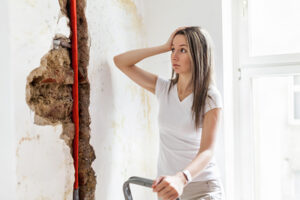Water damage, one of the most common issues faced by property owners, can arise from various sources such as leaks, flooding, and burst pipes, leading to costly repairs and significant stress. The question at the forefront for many is whether their insurance policy provides coverage for such damage. This guide aims to clarify water damage insurance, offering an in-depth understanding of policy coverage, exclusions, and the claim process to help property owners make informed decisions about protecting their property.
Understanding Your Insurance Policy
 Types of Policies and Coverage for Water Damage: Insurance policies differ significantly, but most homeowners’ and commercial property insurance policies include coverage for water damage under certain conditions. It’s essential to distinguish between policies that cover sudden and accidental damage, such as burst pipes, versus those that exclude damage from gradual leaks or lack of maintenance. Additionally, flood insurance is typically separate from standard policies and must be purchased independently.
Types of Policies and Coverage for Water Damage: Insurance policies differ significantly, but most homeowners’ and commercial property insurance policies include coverage for water damage under certain conditions. It’s essential to distinguish between policies that cover sudden and accidental damage, such as burst pipes, versus those that exclude damage from gradual leaks or lack of maintenance. Additionally, flood insurance is typically separate from standard policies and must be purchased independently.
Common Exclusions and Limitations: While many insurance policies cover water damage, there are notable exclusions and limitations. For example, damage due to unresolved maintenance issues, such as a continuously leaking faucet, or damages from natural floods are often not covered under standard policies. This section details these exclusions, emphasizing the importance of understanding your policy’s specific terms and conditions.
The Importance of Maintenance in Insurance Claims
Preventative Measures and Insurance Eligibility: Proactive maintenance plays a critical role in water damage claims. Insurers expect property owners to take reasonable steps to prevent damage, such as regular inspections and timely repairs of known issues. This segment discusses how such preventative measures not only minimize the risk of water damage but also ensure compliance with insurance policy requirements, thereby maintaining claim eligibility.
Documenting Maintenance for Claims: Documentation of maintenance and repairs can significantly impact the success of a water damage claim. This part offers practical tips for keeping detailed records, including dates of repairs, photographs of the work done, and receipts, which can provide critical support during the claims process.
Filing a Claim for Water Damage from Leaks
 Steps to Take Immediately After Discovering a Leak: Immediate action is crucial upon discovering a leak to mitigate damage and comply with insurance requirements. This guide outlines critical first steps, such as stopping the leak, documenting the extent of damage through photos and notes, and promptly notifying your insurance provider to start the claims process.
Steps to Take Immediately After Discovering a Leak: Immediate action is crucial upon discovering a leak to mitigate damage and comply with insurance requirements. This guide outlines critical first steps, such as stopping the leak, documenting the extent of damage through photos and notes, and promptly notifying your insurance provider to start the claims process.
Navigating the Claims Process: The claims process can be complex and overwhelming. This section breaks down the process into manageable steps, offering insights into effectively documenting the damage, submitting a comprehensive claim, and working collaboratively with insurance adjusters and contractors to ensure a fair assessment and repair of the damage.
Challenges and How to Overcome Them: Policyholders often encounter challenges when filing claims for water damage, including disputes over the cause of the damage, coverage limits, and depreciation. This part discusses common obstacles and provides strategic advice on how to address and overcome these challenges, ensuring a smoother claims process.
Preventing Future Water Damage
Upgrading Your Insurance Coverage: Given the limitations and exclusions in many standard policies, upgrading your insurance coverage to include additional protections against water damage might be a prudent decision. This section explores available options for enhancing your policy, such as adding endorsements for sewer backup or overflow, which can provide broader coverage for water-related damages.
Investing in Leak Detection Technology: Advances in technology have made it easier to detect leaks early, potentially preventing significant water damage. This part highlights the benefits of investing in modern leak detection systems, such as smart home devices that monitor for leaks and automatically shut off water supply in case of a detection. It also discusses how such investments can positively impact insurance premiums and overall property protection.
Conclusion
Understanding water damage insurance is essential for effectively protecting your property from the financial impact of leaks and water-related damages. By familiarizing yourself with the specifics of your insurance policy, maintaining your property to prevent leaks, and knowing how to navigate the claims process, you can ensure that you are adequately prepared to deal with water damage. Regular maintenance, thorough documentation, and strategic policy upgrades are key practices that can enhance your coverage and safeguard your investment. As insurance policies and coverage options vary widely, it’s advisable to consult directly with your insurance provider to clarify your coverage details and explore additional protections to fully secure your property against water damage.
FAQs for Water Damage Insurance
1. What types of water damage are typically covered by insurance?
Most homeowners’ and commercial property insurance policies cover sudden and accidental water damage, such as from burst pipes or unexpected leaks. However, gradual damage due to maintenance neglect or natural flooding usually requires separate flood insurance.
2. Are there exclusions to water damage coverage in standard insurance policies?
Yes, common exclusions include damage from unresolved maintenance issues, such as continuous leaks or neglect, and natural floods. Always check your policy for specific terms and conditions.
3. How important is property maintenance in water damage claims?
Regular maintenance is crucial. Insurers expect property owners to conduct regular inspections and timely repairs. Proper maintenance not only reduces the risk of water damage but also ensures compliance with insurance policy requirements, maintaining eligibility for claims.
4. What should I do immediately after discovering a water leak?
First, stop the leak if possible and document the damage with photos and notes. Notify your insurance provider promptly to initiate the claims process.
5. How can I document maintenance and repairs for insurance claims?
Keep detailed records, including dates of repairs, photographs of the work, and receipts. This documentation can be vital during the claims process to support your case.
If you think you might have a leak at home, book an inspection now by clicking the link below.





